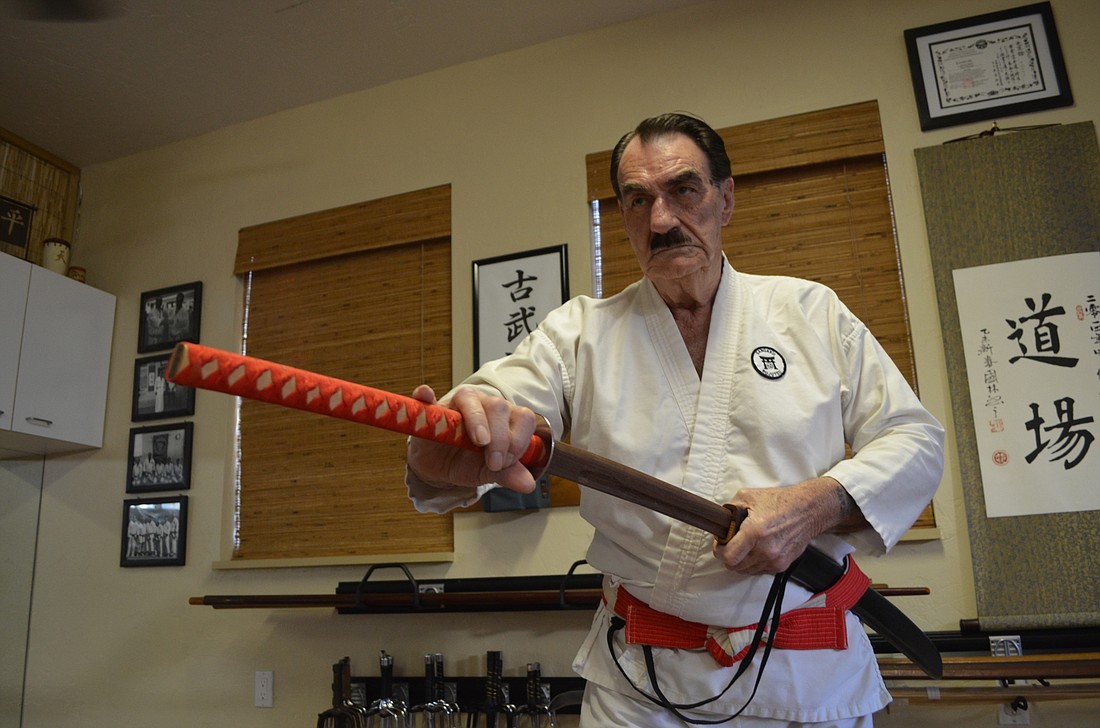- January 23, 2025
-
-
Loading

Loading

James Horne began his martial arts training in 1959 in Okinawa, Japan, while stationed with the U.S. Marine Corps. After returning to the United States in 1962, he continued his training as a member of the 2nd Marine Division Karate Team. Over the past 49 years, Horne has been awarded a master’s degree in karate and teacher’s licenses in several martial disciplines, including kenjutsu and kobujutsu, jujitsu and aikido.
He is the sōke, or founder, of the Sangaku Bujutsu school, based in Sarasota. The school’s motto is: “The hands of a devil. A saint’s heart.”
The school’s style is a blend of Okinawan “empty hand” and weapons techniques. Here, Horne displays another form of martial artistry. He makes all the weapons himself.
We caught up with Horne to talk weaponry, woodworking and the art of the warrior spirit.
You’re not only a master of martial arts. You’ve mastered the creation of martial arts weapons. That’s rare. How did that happen?
I’m no stranger to woodworking. I’ve done carpentry most of my life, even as a boy with my father. When I found that mail order, martial arts weapons were standardized and inferior, I started making my own.
What materials do you use to create your weapons?
Primarily hardwoods, like ironwood and cocobolo. They’re some of the hardest — they don’t break. Obviously, that’s very useful if you’re making a weapon.
Where did you get the templates for your weapons?
From the weapons that I’d already learned to use. I’d been doing martial arts for 25 years when I started, so I was already very familiar with them all. I just adapted the designs to suit the need.
So, there’s no ancient Japanese weapons manual. You reverse-engineered the designs from the weapons you had?
Yes. What guided me was my knowledge of what a weapon should do in a real situation. If you actually had to face an enemy, you certainly wouldn’t want your weapon to break!
Do you make your weapons with machine tools?
I use some machines to cut out the raw materials, which I have to buy in big pieces. I’ll cut out the pieces with a table saw to get them down to relative size. Then I’ll sometimes use a router to create a little bit of shape. After that, I’ll hand-fashion the weapons on a big belt sander.
I understand you customize all of your weaponry.
Yes, and that’s essential. When the time comes to actually use a weapon in self-defense, it should suit you. So, I build my weapons according to each person’s needs and specifications. I fit them to their body size, hand size and intended use.
And I always make sure that the materials will be sufficient for that use.
What’s the historical basis for traditional Okinawan weapons?
When these weapons originated, most Asian societies had weaponry. After King Shō unified Okinawa, he forbid weapons to the peasantry; only his own bodyguards and law-keepers were allowed to carry them.
What remained was a whole society stripped of the means of self-defense. Remember, Okinawa is an island; it was constantly under attack from pirates and bad guys within that society.
How could you defend yourself against those who are weaponized? You used the everyday tools of a farming and fishing community: the bō staff; the jō staff; the tonfa, which were the handles for a grindstone; the nunchaku, which were used as flail for grain and a twitch to control animals. These tools were in the peasants’ hands. Out of necessity, they turned them into weapons.
Sōke, what can you tell us about the June 2016 fire that destroyed your dojo?
The cause of the fire is still a mystery. From what I understand, the fire started in the back of the complex around J.R.’s Old Packinghouse Café. It ate through the buildings pretty quickly because they were so old. I lost everything. Certificates, weapons, mats, bags — everything. I don’t have the clientele to open up a new dojo, but a friend has very graciously allowed me to continue practicing in his home facility with the few students I’ve acquired.
How would you describe your training regimen?
There was a time when I practiced six days a week. Now, I only train a couple of times a week, because of my age and also because of the martial arts clientele, which has seriously changed in recent decades.
In what way?
Years ago, the students who wanted to learn martial arts were a different breed. Students came because they wanted to learn to fight — young men, primarily. Hopefully I led them to a more peaceful outlook.
But, nowadays, most students aren’t fighters — and most dojos are family-oriented. The current breed of commercialized martial arts has taken out a great deal of the martial prowess. What’s left is a system of prearranged forms. You’re ranked on how you perform these movements, and not necessarily on your fighting ability.
The result is a competitive sport. But I prefer the combative aspect.
These weapons are functional pieces — they’re built to do a job. Do you also see them as work of art in their own right?
Yes, I do. I view them that way. I want to make them as beautiful as possible and have them still be totally functional.
They’re very special pieces. When you hold one in your hands, you can feel a spirit about them — an energy.
Good! I’m glad you feel that way.